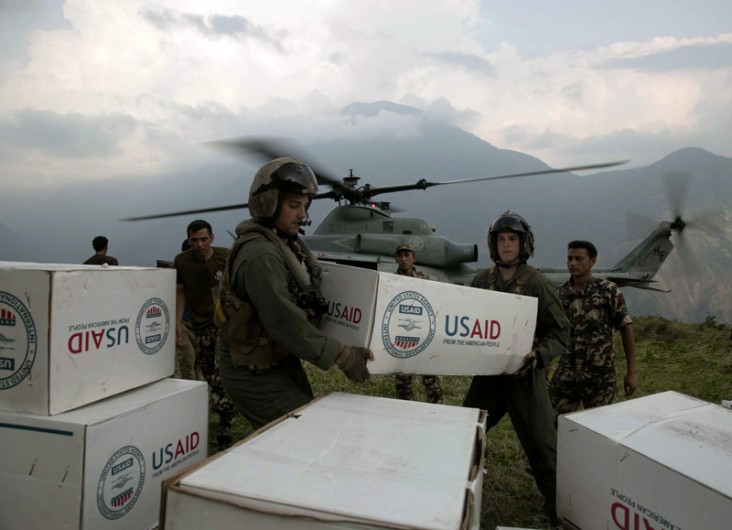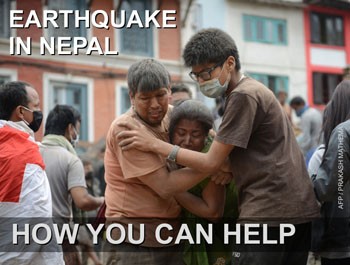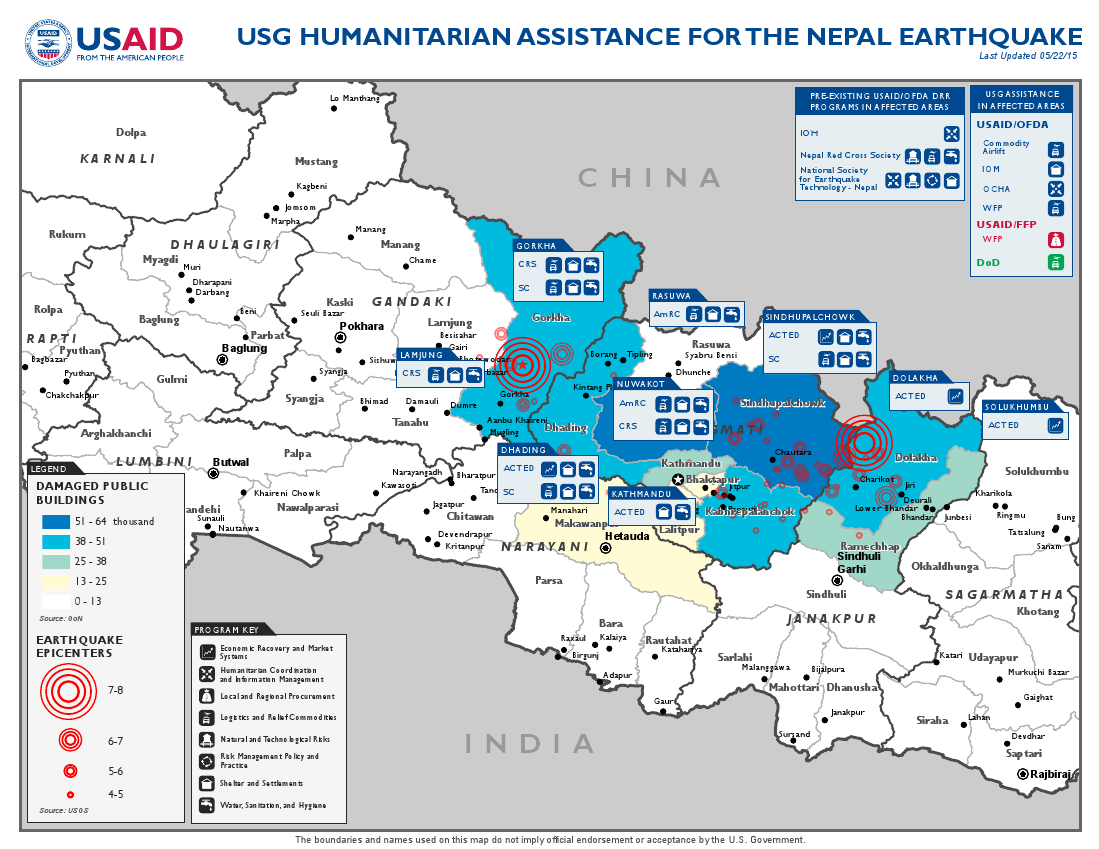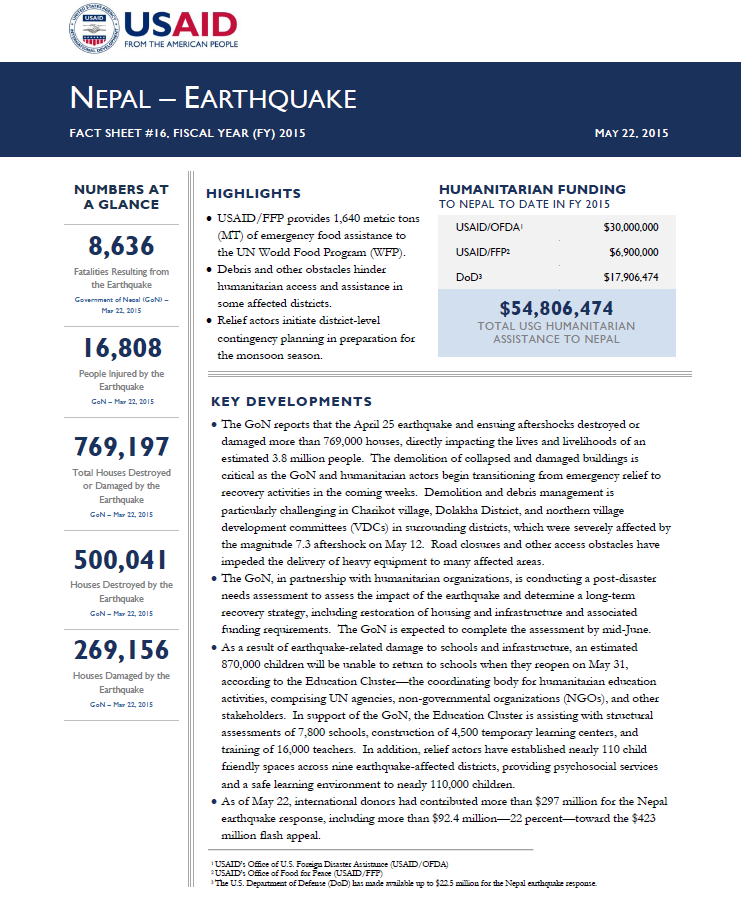May 22, 2015
Highlights
USAID/FFP provides 1,640 metric tons (MT) of emergency food assistance to the UN World Food Program (WFP).
Debris and other obstacles hinder humanitarian access and assistance in some affected districts.
Relief actors initiate district-level contingency planning in preparation for the monsoon season.
Key Developments
The GoN reports that the April 25 earthquake and ensuing aftershocks destroyed or damaged more than 769,000 houses, directly impacting the lives and livelihoods of an estimated 3.8 million people. The demolition of collapsed and damaged buildings is critical as the GoN and humanitarian actors begin transitioning from emergency relief to recovery activities in the coming weeks. Demolition and debris management is particularly challenging in Charikot village, Dolakha District, and northern village development committees (VDCs) in surrounding districts, which were severely affected by the magnitude 7.3 aftershock on May 12. Road closures and other access obstacles have impeded the delivery of heavy equipment to many affected areas.
Nepal Earthquake Map - May 22, 2015 ![]() (pdf - 971k)
(pdf - 971k)
Numbers At A Glance
8,636
16,808
769,197
500,041
269,156
Humanitarian Funding:
To Nepal To Date In FY2015:
| USAID/OFDA | $30,000,000 |
| USAID/FFP | $6,900,000 |
| DoD | $17,906,474 |
| TOTAL | $54,806,474 |
Nepal Earthquake Fact Sheet #16 - 05-22-2015 ![]() (pdf - 209k)
(pdf - 209k)
The GoN, in partnership with humanitarian organizations, is conducting a post-disaster needs assessment to assess the impact of the earthquake and determine a long-term recovery strategy, including restoration of housing and infrastructure and associated funding requirements. The GoN is expected to complete the assessment by mid-June.
As a result of earthquake-related damage to schools and infrastructure, an estimated 870,000 children will be unable to return to schools when they reopen on May 31, according to the Education Cluster—the coordinating body for humanitarian education activities, comprising UN agencies, non-governmental organizations (NGOs), and other stakeholders. In support of the GoN, the Education Cluster is assisting with structural assessments of 7,800 schools, construction of 4,500 temporary learning centers, and training of 16,000 teachers. In addition, relief actors have established nearly 110 child friendly spaces across nine earthquake-affected districts, providing psychosocial services and a safe learning environment to nearly 110,000 children.
As of May 22, international donors had contributed more than $297 million for the Nepal earthquake response, including more than $92.4 million—22 percent—toward the $423 million flash appeal.
LOGISTICS AND RELIEF COMMODITIES
Humanitarian organizations have initiated contingency planning at the district level in preparation for the onset of the monsoon season in June. Pre-positioning of emergency relief commodities and food assistance is essential to ensure that assistance reaches earthquake-affected populations in remote VDCs, according to the UN.
As of May 22, the majority of U.S. military air assets and remaining Joint Task Force 505 personnel had departed Nepal. A six-person team from the 36th Contingency Response Group (CRG)—the U.S. Air Force unit specializing in airfield management that has been working at Nepal’s Tribhuvan International Airport (TIA)—will remain in the capital city of Kathmandu to continue providing the Nepalese military with training and technical assistance to ensure a sustainable transition of logistics responsibility. The team will help ensure that humanitarian supplies continue to transit through TIA to relief organizations and reach populations in need.
The UN Humanitarian Air Service (UNHAS) fleet—expected to expand to six helicopters in the coming weeks—has conducted nearly 240 flights to more than 40 destinations, transporting more than 330 passengers and nearly 100 MT of humanitarian cargo.
SHELTER
The GoN reports that the April 25 earthquake and ensuing aftershocks destroyed or damaged more than 769,000 houses in Nepal. To date, USAID/OFDA has delivered 6,200 rolls of plastic sheeting to provide emergency shelter assistance for approximately 62,000 earthquake-affected households. In total, Shelter Cluster partners have provided 192,000 tarpaulins and 34,000 household kits, including nearly 14,600 tarpaulins and more than 13,500 household kits between May 18 and 21, according to the UN. Additionally, the GoN had distributed more than 230,500 tarpaulins as of May 21.
The GoN and humanitarian actors will likely begin transitioning from emergency relief to recovery activities in the coming weeks, and the demolition of collapsed and damaged structures is essential to begin rebuilding. Additionally, the demolition of damaged buildings decreases the risk of collapse during future aftershocks, improving safety. Demolition and debris management is particularly challenging in Charikot village and northern areas of neighboring districts, which were severely affected by the May 12 aftershock. Road closures and other obstacles are impeding the delivery of heavy equipment to demolish damaged buildings and remove rubble, the UN reports.
The International Organization for Migration (IOM) is operating a cash-for-work debris removal program—currently employing 30 Nepalis—in Chautara Municipality, Sindhupalchowk District, which is a key transport corridor and economic and political hub. Prior to the April earthquake, USAID/OFDA, in coordination with the GoN, UN, NGOs, and civil society organizations, had supported IOM to develop a debris management plan. The program pre-identified rubble disposal resources and high-risk sites in Nepal’s capital city of Kathmandu and established guidance and standardized procedures for rubble removal, processing, recycling, and disposal.

FOOD SECURITY AND LIVELIHOODS
The Cash Coordination Group (CCG), led by WFP in coordination with the GoN, has developed a rapid assessment of markets (RAM) tool for use by relief actors to improve collection of common market data on basic relief commodities, including household items, corrugated iron sheets, and water, sanitation, and hygiene (WASH) supplies. The assessments help determine the need for cash assistance and other market interventions, and relief actors can directly upload RAM data and results to CCG via a cellular phone application. The goal of RAM is to capture overall market functionality across affected areas.
USAID/FFP is providing 1,640 MT—valued at $4.4 million—of in-kind emergency food assistance from its warehouse in Colomba, Sri Lanka, to WFP to bolster food security for earthquake-affected populations. To date, USAID/FFP has provided a total of $6.9 million in support of WFP’s emergency food assistance operations in Nepal. As of May 20, WFP had distributed nearly 3,000 MT of rice and High Energy Biscuits to approximately 1.6 million people in seven of the most-affected districts.
NUTRITION AND WASH
To date, nutrition actors have treated more than 3,000 children experiencing severe acute malnutrition in the 14 districts most affected by the earthquake. Response actors continue to conduct community-based screening for malnutrition, measuring mid-upper arm circumference, and have established nearly 30 centers for treating malnutrition. Between May 18 and 21, nutrition partners conducted approximately 700 counselling sessions on best practices for infant and young child feeding, reaching more than 5,200 mothers in the 14 most-affected districts.
As of May 18, WASH Cluster partners had reached 584,000 people with emergency water interventions, 420,000 people with hygiene kits and other hygiene interventions, and 34,000 people with sanitation support. Given logistics challenges related to delivering WASH assistance, the WASH Cluster has encouraged partners to assist with recovery and reconstruction efforts, including providing cash vouchers to support rebuilding latrines and purchasing hygiene supplies.
The WASH Cluster is refining technical standards for WASH interventions and finalizing the WASH response plan, which will be incorporated in the revised UN flash appeal for the Nepal earthquake. WASH Cluster partners report that relief organizations have not accessed 13 hard-to-reach VDCs in Sindhupalchowk District; the USAID Disaster Assistance Response Team (DART) WASH adviser is coordinating with USAID/OFDA partners operating in the district to assess potential WASH interventions.
CONTEXT
On April 25, a magnitude 7.8 earthquake struck central Nepal’s Gorkha District, approximately 77 kilometers (km) northwest of Kathmandu, at a depth of approximately 15 km, according to the U.S. Geological Survey (USGS).
The USG immediately issued a disaster declaration for Nepal due to the effects of the earthquake. Within hours of the seismic event, USAID/OFDA activated a Response Management Team (RMT) in Washington, D.C., and deployed a DART—including urban search-and-rescue specialists—to support emergency response efforts in Nepal.
On May 12, a magnitude 7.3 aftershock struck Nepal’s Dolakha District, approximately 76 km northeast of Kathmandu, according to USGS. The aftershock caused further casualties and damages in areas affected by the April 25 earthquake.
For nearly two decades, USAID/OFDA has supported disaster risk reduction (DRR) efforts in Nepal, including throughout Kathmandu Valley. USAID/OFDA funding has enabled partners to identify, prepare, and preserve more than 80 open spaces in Kathmandu Valley for humanitarian purposes; pre-position critical emergency relief supplies; and strengthen earthquake response capacity at the local and national levels in collaboration with the GoN, non-governmental organizations, private companies, and local communities. More information on USAID/OFDA’s DRR programs in Nepal and throughout South Asia is available at www.usaid.gov/what-we-do/working-crises-and-conflict/disaster-risk-reduc....
PUBLIC DONATION INFORMATION
The most effective way people can assist relief efforts is by making cash contributions to humanitarian organizations that are conducting relief operations. A list of humanitarian organizations that are accepting cash donations for disaster responses around the world can be found at www.interaction.org.
USAID encourages cash donations because they allow aid professionals to procure the exact items needed (often in the affected region); reduce the burden on scarce resources (such as transportation routes, staff time, and warehouse space); can be transferred very quickly and without transportation costs; support the economy of the disaster-stricken region; and ensure culturally, dietary, and environmentally appropriate assistance.
More information can be found at:
- The Center for International Disaster Information: www.cidi.org or +1.202.821.1999.
-
Information on relief activities of the humanitarian community can be found at www.reliefweb.int.










Comment
Make a general inquiry or suggest an improvement.